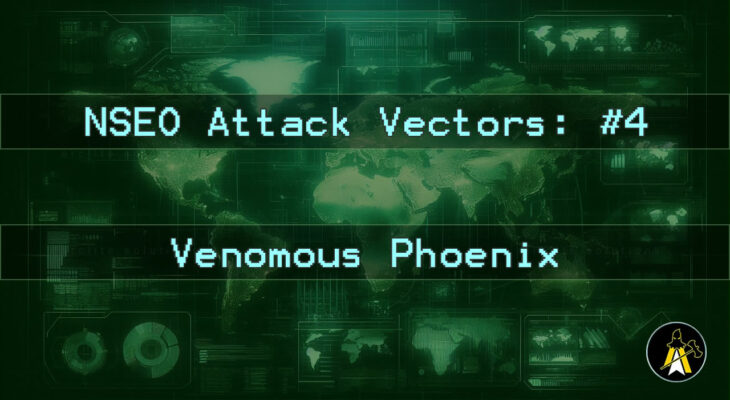The Venomous Phoenix is able to utilize a number of other Negative SEO attack vectors, such as the Canonical Link Attack, Content Hijacking, and even Impersonation, to create a multi-prong offensive which can carry truly devastating effects for its target website.
At the base-level, this type of attack is designed to transfer a Google Manual Action from attack site to victim site, but more sophisticated versions of the Venomous Phoenix attack have more far-reaching and permanent SERP ranking effects, due to the fact that they will transfer Algorithmic Markdown, which basically turns this vector into a stealth attack. Negative effects are further compounded by Google’s outright refusal to even acknowledge the existence of this type of NSEO attack, and its consequent refusal to take any action to mitigate or nullify its effects.
Breakdown of a Venomous Phoenix Attack
Step 1: Find a Penalized, Dropped Domain:¹
First and foremost, the Venomous Phoenix attack requires a toxic domain name in order to achieve the maximum negative impact against its intended target.
There is of course no shortage of “Expired Domain Websites,” and most of them offer free email alerts about domain names which will expire soon, so finding candidate names is both simple, and – more importantly – automatable.
In essence, what an attacker looks for during this stage, is a selection of “Exact Match Domain Names” for his chosen victim’s industry or market sector, because EMDs are far more likely to have been used for spammy purposes. Ergo, they are more likely to carry latent manual actions or have suffered Google’s algorithmic markdown.
Once the Negative SEO attacker has compiled a shortlist of likely domains, all he or she needs to do is carry out a short inbound link analysis of these, and run a quick content-check over at Archive.org, to identify the most potentially lethal ones.
There are other ways to refine this selection process in order to identify the TRULY VENOMOUS domain names contained in the shortlist. These are beyond the scope of this article, as they would turn this piece into a “How to…” instruction manual.
¹ An attacker can also use his or her own domain, which they know has already been penalized.
This done, the attacker moves on to the next phase.
Step 2: Populate Your Venomous Phoenix Site with Trash
With a truly toxic domain, there’s every chance that the search of Archive.org will yield a massive amount of low-quality, spammy garbage content which led to the original site’s penalization or algorithmic markdown (read:loss of rankings.) At that stage populating the Venomous Phenix site becomes a matter of simply scraping the spam content from the Internet Archive and reloading it using its original filenames and directory structure.
This will ensure that any latent penalty or algorithmic markdown will remain in full force. For added bonus points, this approach will also restore any and all spam links to their original URLs. This, in turn, will likely exacerbate any negative consequences which are passed on to the victim.
Alternative Approach: Creating thousands of pages of AI-generated garbage, based on the target site’s own content and market sector, will create a more customized – and potentially impactful – Negative SEO attack than simply restoring the Phoenix site’s original, toxic content.
Step 3: 301 Redirect or Canonicalize to Your Victim
Once the attack site is stocked with content, the attacker simply needs to sit back and wait for Google to crawl his or her site, before either deploying an across-the-board 301 redirect from the Venomous Phoenix site to the victim site, or to selectively canonicalize the worst of the worst content against specific – and potentially profitable/productive – sections of the target website.
Again, we are omitting several ways to refine this aspect of the Venomous Phoenix attack vector, because this is an information piece, not an instruction manual.
NOTE: Unsophisticated versions of the Venomous Phoenix NSEO attack vector will ignore steps 1 and 2, and instead rely on resurrecting multiple (sometimes dozens) of spammy domain names, and then 301 redirecting them to the victim’s website straight-away, without bothering to restore any content to these domains.
While this approach is quicker, and can carry pronounced negative SERP-ranking consequences for the victim website, its effects are also easier to mitigate and less permanent, compared to a properly implemented attack.
How to Defend Your Site Against a Venomous Phoenix Negative SEO Attack
There’s no viable defense, but that’s not the worst part about this type of NSEO. What makes the Venomous Phoenix such a potentially devastating Negative SEO attack vector is the complete lack of any coherent way to reliably mitigate its impact on the victim’s website, if the attack domain transfers algorithmic markdown, and not simply a Google Manual Action.
If a Venomous Phoenix attack results in a Manual Action being transferred to the target site via 301 redirects, the remedial course of action is a simple reconsideration request, filed through the Google Search Console system, and explaining the situation in detail.
This should result in the Manual Action being lifted in short order.
If, on the other hand, the Venomous Phoenix incorporates a Canonical Link Attack, then there’s literally no way to remedy the situation unless you’re able to identify the attack site beyond any reasonable doubt. Detection and identification, however, are made difficult or impossible by the fact that neither Google Analytics, nor any other currently available analytics platform are able to detect the canonicalization of any URL containing inbound links to an affected website.
Worse, if the attack is purely Canonical in nature, there’s basically no way to trace it, unless Google finally takes the long overdue action of flagging external canonicalization, as part of its Search Console ecosystem.
Google, however, is not likely to take any such action, as the search giant is far too busy denying the very existence of the Venomous Phoenix Negative SEO Attack Vector, to actually take any constructive action against it.

